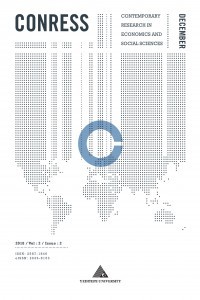Osmanlı Tiyatrosu’nda Modernleşmenin İzdüşümleri
Sanatçılar bir toplumun gerek ihtiyaçlarını gerek sorunlarını en iyi algılayan ve en iyi betimleyen bireylerin başında gelirler. İcra ettikleri sanatla, kimi zaman hayalini kurduğu, kimi zaman da eleştirdikleri düzeni topluma aktarmaya çalışırlar. Bir sanat formu olarak tiyatro, bu aktarıcıların en önemlilerindendir. Bu çalışmada 1839-1908 yılları arasında Osmanlı Tiyatrosu’nun modernleşme sürecindeki rolü, çeşitli oyun incelemeleriyle analiz edilecektir. Bu analiz yapılırken, mevcut modernleşme yaklaşımları bağlamında, öncelikle modernleşmenin belirleyici unsurları araştırılacak, sonra da tiyatro oyunlarında bu belirleyici unsurların izi sürülecektir. Toplumsal gerçeklik bağlamında ele alınacak eser incelemelerinde, yazarların, izleyiciye hangi mesajları ne şekilde iletmek istedikleri, yine eserlerde yer alan konuşma metinleri üzerinden saptanacaktır.
Anahtar Kelimeler:
Modernleşme, Geleneksel Düzen, Modernleşme Kuramları, Tiyatro, Osmanlı Tiyatrosu
The Traces of Modernization in the Ottoman Theatre
Generally, artists are the people who feel and perceive the basic needs of the society prelusively. They took the photograph of the society which they lived in and used this photography in their art. The main objective of this article is to look for, study, and analyze the answers to the following question: "How did theatre contribute to this new era which started in 1839 and led to change and modernization?" The literary theory that will be used for analyzing the theatre texts will be the social realism theory, which refers that “art is the reflection of the society”. The structure of the thesis generates from theory to practise. With this configuration, the scope will get narrower towards the end of the subjects. The first important concept of the thesis is the modernization and the modernization theories. And then, the common denominators of the modernization will be discussed. This will be one of the most important parts of the study because the concepts that are searched in the theatre texts between 1839-1908 in the last part of the article will be the reflections of this first part.
___
- Almond, G. A. ve Powell, G. B. (1966). Comparative politics, a developmental approach. Boston: Little, Brown and Co.
- And, M. (1971). Tanzimat ve İstibdat Döneminde Türk Tiyatrosu. Ankara: Türkiye İş Bankası Kültür Yayınları.
- And, M. (1994). Osmanlı Tiyatrosu. Ankara: Dost Yayınları.
- Baronyan, H. (2013). Baronyan Oyunları: Bağdaşar Ağpar ve Heşmetlü Dilenciler. İstanbul: BGST Yayınları.
- Berkes, N. (2010). Türkiye’de Çağdaşlaşma. İstanbul: Yapı Kredi Yayınları.
- Berman, M. (2004). Katı Olan Her Şey Buharlaşıyor. İstanbul: İletişim Yayınları.
- Black, C. E. (1986). Çağdaşlaşmanın itici güçleri. Ankara: Türkiye İş Bankası Kültür Yayınları.
- Deutsch, K. W. (1962). Nationalism and social communication. Boston: The M.I.T. Press.
- Erginün, İ. (1998). Namık Kemal’in Eğitim Konusunda Görüşleri. Ölümünün 100. Yılında Namık Kemal içinde (ss. 25-38). İstanbul: Marmara Üniversitesi Yayınları.
- Feraizcizade, M. Ş. (2002). İlk Göz Ağrısı. İstanbul: Mitos-Boyut Yayınları.
- Gellner, E. (2008). Uluslar ve Ulusçuluk. İstanbul: Hil Yayınları.
- Giddens, A. (2010). Modernliğin Sonuçları. İstanbul: Ayrıntı Yayınları.
- Hall, S. ve Gieben, B. (1992). Formations of modernity. London: The Open University Press.
- Hobsbawm, E. (2008). Devrim Çağı. Ankara: Dost Yayınları.
- Huntington, S. P. (1966). Political Modernization: America vs. Europe. World Politics, 18(3), 378–414.
- Karpat, K. H. (1972). The transformation of the Ottoman State, 1789-1908. International Journal of Middle East Studies, 3(3), 243–281.
- Kemal, N. (1994). Vatan Yahut Silistre. İstanbul: Remzi Kitabevi Yayınları.
- Kemal, N. (2003). Gülnihal. İstanbul: Bordo Siyah Klasik Yayınları.
- Kemal, N. (2009). Zavallı Çocuk. İstanbul: Bilge Kültür Sanat Yayın Dağıtım San. Ve Tic. Ltd. Şti.
- Küçük, M. (2011). Modernite versus Postmodernite. İstanbul: Say Yayınları.
- Lerner, D. (1958). The passing of traditional society: Modernizing the Middle East. New York: The Free Press.
- Mardin, Ş. (2009). Türk Modernleşmesi. İstanbul: İletişim Yayınları.
- Nutku, Ö. (2000). Dünya Tiyatrosu Tarihi 1. İstanbul: Mitos-Boyut Yayınları.
- Oktay, C. (2005). Siyaset Bilimi İncelemeleri. İstanbul: Alfa Yayınları.
- Pekman, Y. (2010). Çağdaş Tiyatromuzda Geleneksellik. İstanbul: Mitos-Boyut Yayınları.
- Pye, L. (1966). Aspects of political development. Boston: Little Brown&Company.
- Rostow, W. W. (1965). The stages of economic growth: a non - communist manifesto. London: Cambridge University Press.
- Rustow, D. A. (1968). Modernization and Comparative Politics: Prospects in Research and Theory. New York: New York University Press.
- Shaw, S. J. (1965). The Nizam-I Cedid Army under Sultan Selim III 1789-1807. Brill, 18(19), 168–184.
- Shaw, S. J. (1977). History of the Ottoman Empire and Modern Turkey, Volume II: Reform, Revolution and Republic, The Rise of Modern Turkey. London: Cambridge University Press.
- Shils, E. (1971). Tradition. Comparative Studies in Society and History, 13(2), 122-159. doi:10.1017/S0010417500006186
- Şinasi, İ. (2010). Şair Evlenmesi. İstanbul: Remzi Kitabevi.
- Tarhan, A. H. (2002). Abdülhak Hamid Tarhan Tiyatroları 7 Macera-yı Aşk. İstanbul: Dergah Yayınları.
- Tiyatrı Eleştirmenleri Birliği. (1994). Eleştirmen Gözüyle-Cumhuriyet Dönemi Türk Tiyatrosu Eleştiri Seçkisi. Ankara: T.C. Kültür Bakanlığı Yayınları.
- Winham, G. R. (1970). Political Development and Lerner’s Theory: Further Test of a Casual Model. American Political Science Review, 64(3), 810–818.
- Yücekök, A. N. (1984). 100 Soruda Türk Devrim Tarihi. Ankara: Ankara Üniversitesi Siyasal Bilgiler Fakültesi Yayınları.
- ISSN: 2587-1846
- Başlangıç: 2017
- Yayıncı: Yeditepe Üniversitesi
Sayıdaki Diğer Makaleler
Türkiye’den Göç Etmiş Azınlıklar Diasporasında Kültürel Miras Olarak Türk Dili
Politik Bir Fenomen Olarak Ekmek: 2008 Mısır'ında Ekmek İsyanı
Osmanlı Tiyatrosu’nda Modernleşmenin İzdüşümleri
Küresel Finansal Krizin AB Üyelerinde Sermaye Hareketliliğine Olan Etkisi
Almanya ve Türkiye’de Devlet ve Ulus İnşası Süreçlerinin Kıyaslanması
